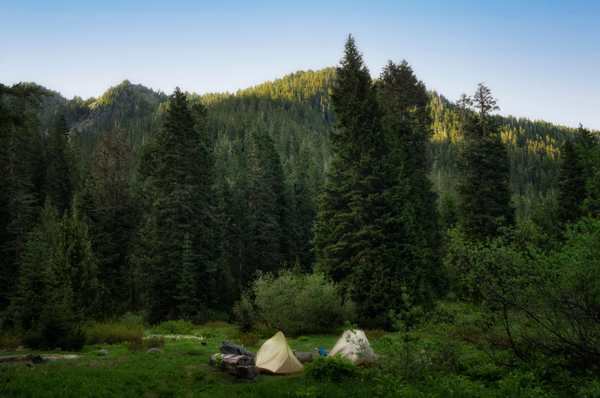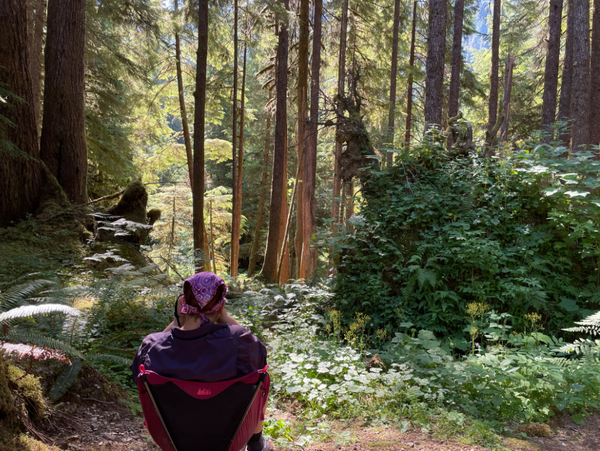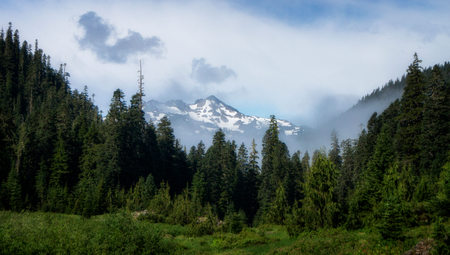
With my wrist in the strap of my trekking pole, I dangle over bright gray boulders bordering frothy water tumbling through the chasm. My brain is trying to comprehend what has happened. Just a few minutes ago I was hiking a wide, easy trail, and now I am hanging below it.
I can feel solid ground with my toes, and I loosen my grip from my trekking pole to stumble a few feet down the steep slope before planting my butt on the ground. I look at the waterfall below me, the water just 20 feet away from me, noting the sharp-edged rocks lining the rapids. My mind still cannot comprehend what has happened.
Me, my sister Kristi, and our friend Hugh began a backpacking trip from the North Fork Quinault River trailhead over Low Divide eight days earlier. We planned to camp for a couple nights in the Elwha River Basin under towering Hemlocks along the boisterous river. We know our trip will be filled with challenges, but we come prepared.
We start just after the extreme heat dome of June 2021. Recent trail reports tell us that the North Fork Quinault River is running high and fast. To help belay us across in case we need it, Hugh brought along a rope to use on days two and eight of our intended route.
When we reach the river on day two, it is running as the reports foretold – high and fast. The rangers advise that we cross above the rapids, where the water is a bit shallower and should, theoretically at least, be easier to cross. I look at the river, suck in a big breath of air, and think, I can do this. It doesn’t look too bad, and I can see that the river is a bit shallower just above the rapids. What I don’t see is how big the rocks are below the surface – the water distorts their shapes.
Crossing the North Fork Quinault River on my own without a belay, the river dragging at my feet and trekking poles, is the most frightening thing I have ever done. The water splashes up to my belly and pulls at my feet. As I try to maneuver around a large rock, I feel as though I’m one move away from being washed away; that I will eventually be found miles downstream.
By some miracle, I make it, heart pounding yet exhilarated, and I help Hugh belay Kristi across. We all devise a plan on how to safely get back to the other side of the river on our way back out.
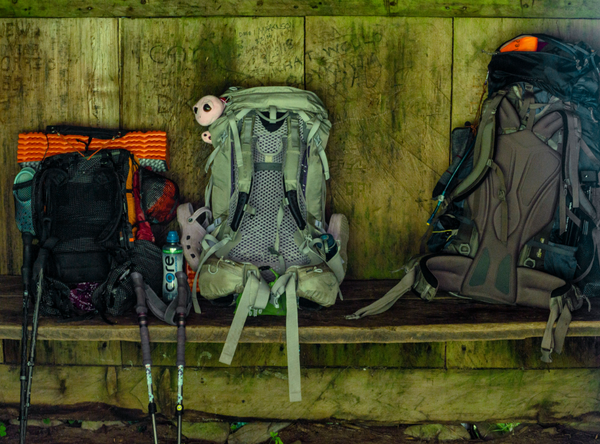 Heidi, Kristi, and Hugh's backpacks in the Trapper Camp Shelter.
Heidi, Kristi, and Hugh's backpacks in the Trapper Camp Shelter.
Falling to my death is not what frightens me – it’s the falling to my maimement. Surviving the fall but being in so much pain that life itself becomes an unbearable burden, that’s what scares me the most. I know how to self-arrest. I’ve taken the classes and practiced with my ice axe on snow, but can I execute a self-arrest on loose rock and scree with a trekking pole? I really don’t want to find out, and that’s why I’m dismayed when we encounter several washouts on the trail, leaving nothing more than a narrow boot path to follow. I hate washouts, especially the ones high on the slope with a long steep drop to a tumble of rocks and trees below. They cause me more anxiety than the thought of turning a corner and coming nose-to-nose with a mama bear.
With coaching from friends in The Mountaineers, I’ve learned how to cross steep areas of wash outs: don’t look down the slope, don’t look up the slope, keep your eyes on the trail, always look a step or two in front of you, make sure your footing is solid before shifting your weight, use your trekking poles to keep your stability. With each washout, I repeat this advice in my head like a mantra. I’m thankful for their encouragement and for Mountaineers courses getting me past so many of these fears on the trail. I make it across each wash out in both directions.
On our return to the river on day eight, it’s running noticeably lower, but still swiftly. The water only reaches my knees, yet is powerful enough to drag at my feet, making each step an exercise in concentration. We cross first thing in the morning and don’t need a belay, but are happy to have the option.
Back on the original side of the river, I think we’re home free. I know the trail ahead to be free of obstacles; it’s generally flat, wide, and happy. About a mile from our camp for the evening, I glance behind to make sure I can see Hugh and Kristi, who stopped for photos. I want to make sure I don’t get too far ahead.
I see Hugh, no more than twenty feet away. I turn back around to evaluate the waterfall in front of me. The water cascades down the slope that the trail traversed - it starts on the hill above us, cascades down over the trail, and then drops steeply into a ravine. We have needed water shoes before, but will I need water shoes today?
The group's camp at Low Divide.
I’m contemplating the water shoes conundrum when I stumble. Something snags my toe and the weight of my pack shifts at the sudden lurch, pulling me downhill. Ground rushes toward my face. I bounce down the slope, flipping through the air over an embankment before jerking suddenly, and mercifully, to a stop – my wrist still looped in the strap of my trekking pole.
My trekking pole somehow arrests my fall. I am dangling in a ravine, 12 feet down along its walls. 20 feet further down the ravine I can see rocks with water rushing past. Landing on the rocks below would have been so much worse, I realize slowly as I gain my bearings. I release myself and fall a few feet to the rocks, where I find myself trembling. I try to calm my racing heart, resting my elbows on my knees, head between my hands. My mind focuses on repeating a certain obscene word – a new mantra of mine – as I take deep, calming breaths. I think of Hugh looking for me. I can’t hear him calling my name over the roar of the waterfall. Turning my eyes skyward, I see my trekking pole suspended over the ravine but the face I was hoping to see searching for me is absent. Where is Hugh? And Kristi? And what the hell am I going to do to get myself out of here?
The 2021 Mountaineers safety report shows that the majority of incidents on trails are “slips, trips, and falls caused by distraction.” My accident falls right into that description (pun intended). I was distracted, not watching the trail at my feet, and ended up suspended by my arm over a waterfall ravine.
I look around at the slope to see the gear stored on the outside of my pack lying on the ground: camera, tent poles, and tripod. I pick up the tent poles with my right hand and try folding them back into their compact fold, but have difficulty with the trekking pole still in my left hand. Shoot. How am I supposed to fold the poles with a trekking pole in my hand?
I come to realize later that the higher functions of my brain are shutting down, something that happens when your body experiences trauma. I didn’t hit my head, but my brain is still affected, going into survival mode to save energy by shutting down reasoning skills to keep the rest of me alive. I call it reverting to my lizard brain – a brain of instinct and reaction. I can’t even reason that if I put down the trekking pole, I can then use both hands to fold my tent poles. Defeated, I put the tent poles down and reach for the camera, set it on a rock next to me, and look up toward the trail again. Nothing.
I taste blood and run my tongue along my teeth to make sure I’m not missing any. No teeth gone. I raise a hand to check my lips, and that’s when I notice the blood smeared across my thigh where my elbow had rested. I look at my elbow to see skin hanging off in a roll. I feel no pain as I quickly yank it with my hand, leaving an inch of skin on the ground. As I press a bandana against the wound, I look up across the ravine at the sight of movement on the other side of the waterfall. Why is Hugh on the other side, walking away from me? Isn’t he looking for me? Didn’t he see me fall?
No, he didn’t.
Even though he was not far behind me, within eyesight and earshot, he didn’t see me disappear over the edge of the ravine. Nor did he hear my screams as I fell.
Heidi resting at camp after her fall.
But he hears me now as I yell to get his attention, my voice carried across the waterfall. With a bit more yelling and waving, I get him to understand that I have fallen and need help. I look for the best route to get back on the trail, but trying to scramble out while holding onto the gear that should be in my pack seems impossible. It still hasn’t occurred to me to remove my pack and re-secure the strewn items to it.
Hugh scrambles down to me and immediately tells me to take off my pack. I stare at him blankly. He repeats the request, and I finally unlatch the hip belt and chest strap. Hugh takes it from me and places it on the ground. “Ok, let’s take a look at your injuries,” he says. He grabs the bandana I have clutched at my elbow, soaks it in the waterfall, and begins to wipe away dirt and blood to see my external injuries.
“Did I cut my lip? I taste blood.”
“You have a little cut, but it’s not bad.”
I become fixated with the taste of blood, imagining my mouth filling with blood and having no idea where it came from.
Seeing that we are below the trail, my sister finally catches up to us and asks what was going on. Hugh explains that I fell and require bandages. She drops her pack while Hugh helps me out of the ravine. With relief, I sit down on a wide, flat rock away from the cliff. Kristi takes over evaluating my injuries as Hugh cleans up my gear and hoists it out of the ravine. Kristi works efficiently – after years raising an accident-prone son, she has gained mastery in the field of first aid. Hugh sits next to my sister, handing her gauze, tape, and bandages as directed. She puts butterfly bandages on my elbow then wraps it in gauze and what we Walker girls call vet-wrap – a self- sticking bandage wrap that we used on the horses and goats on the farm. I ask my sister about the cut on my lip, and she confirms that it is barely noticeable. I can’t help myself from running my tongue across my teeth looking again for the one that’s missing.
“Where’s my trekking pole?”
Kristi points to the pole next to me. “No, the other one. I should have two.”
Hugh walks back up the trail to where I fell. “It’s right here, let me get it.” He pulls lightly, and then he tugs. No one expects this battle. He gives it a hard yank and it finally comes free of the root ball in which it had become entangled. How my trekking pole managed to become so deeply lodged that it could hold my fall will forever remain a mystery, but it’s one for which I will forever be grateful.
Due to my condition, it takes us several hours to travel the one mile to camp for the night, and then another two days to hike the last ten miles out. Kristi and Hugh let me set the pace, and I stop when I need to. I try to ignite the farm girl in me, the part of me that did her chores when sick because they needed to be done, and I focus on the trail and powering through hills and stream crossings. When we stop, I leave my pack on – it’s less painful that way. In truth, the hike out is a blur, interrupted by one blissful afternoon spent sitting in the cool, turquoise waters of the North Fork Quinault River.
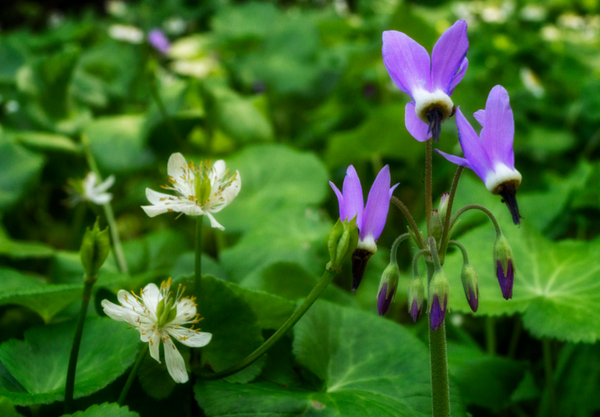 Shooting star flowers along the trail at Low Divide in July.
Shooting star flowers along the trail at Low Divide in July.
It’s not until the night after leaving the trail that I notice a deformity in my bicep and swelling in my right hand. A few weeks later, I will sit in an orthopedic surgeon’s office looking at an MRI of my shoulder. I will need surgery to repair a torn rotator cuff, and I will eventually regain about 90% of the strength in my bicep through physical therapy. Recovery of my physical strength will take nearly a year, and the recovery of my mental state will take nearly as long.
My lizard brain will continue to dominate my life for months. I will struggle at work to move beyond the routine tasks; struggle in my creative life, leaving photos unprocessed and stories unwritten; struggle on the trail, my confidence shattered. Trails with short drop-offs will frighten me, and I cling to the mantra given to me by my friends: don’t look down or up, look a few feet ahead of you on the trail, make sure your step is solid before transferring your weight. And use your trekking poles.
This article originally appeared in our fall 2022 issue of Mountaineer magazine. To view the original article in magazine form and read more stories from our publication, visit our magazine archive.
 Heidi Walker
Heidi Walker
